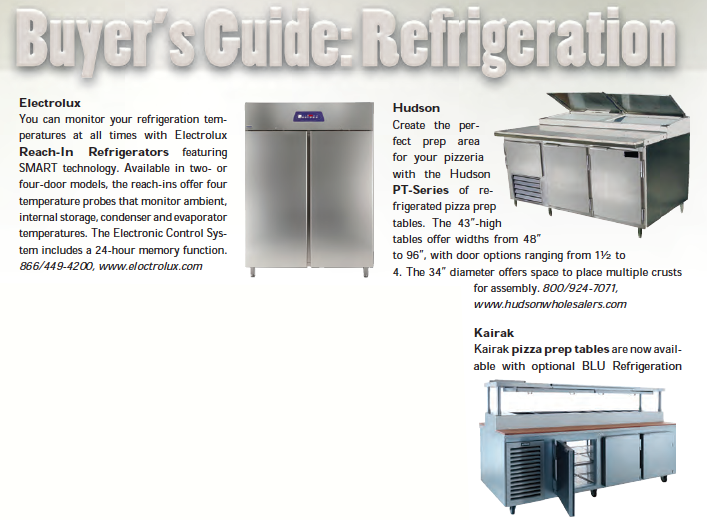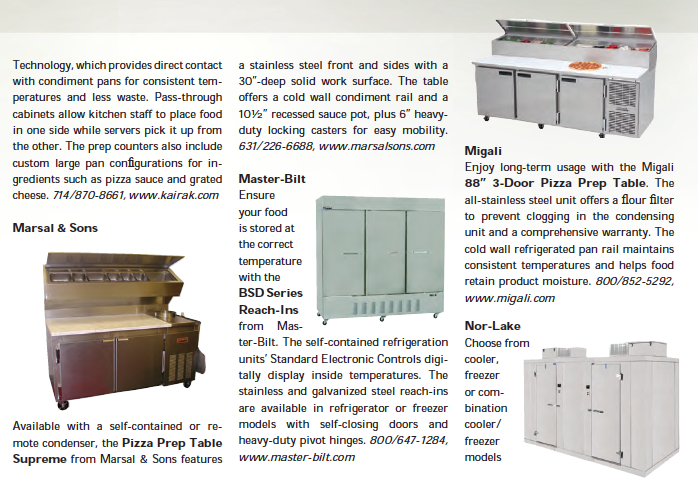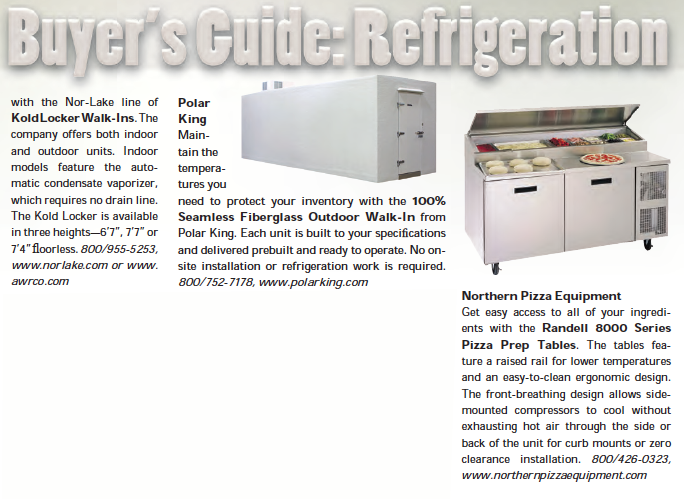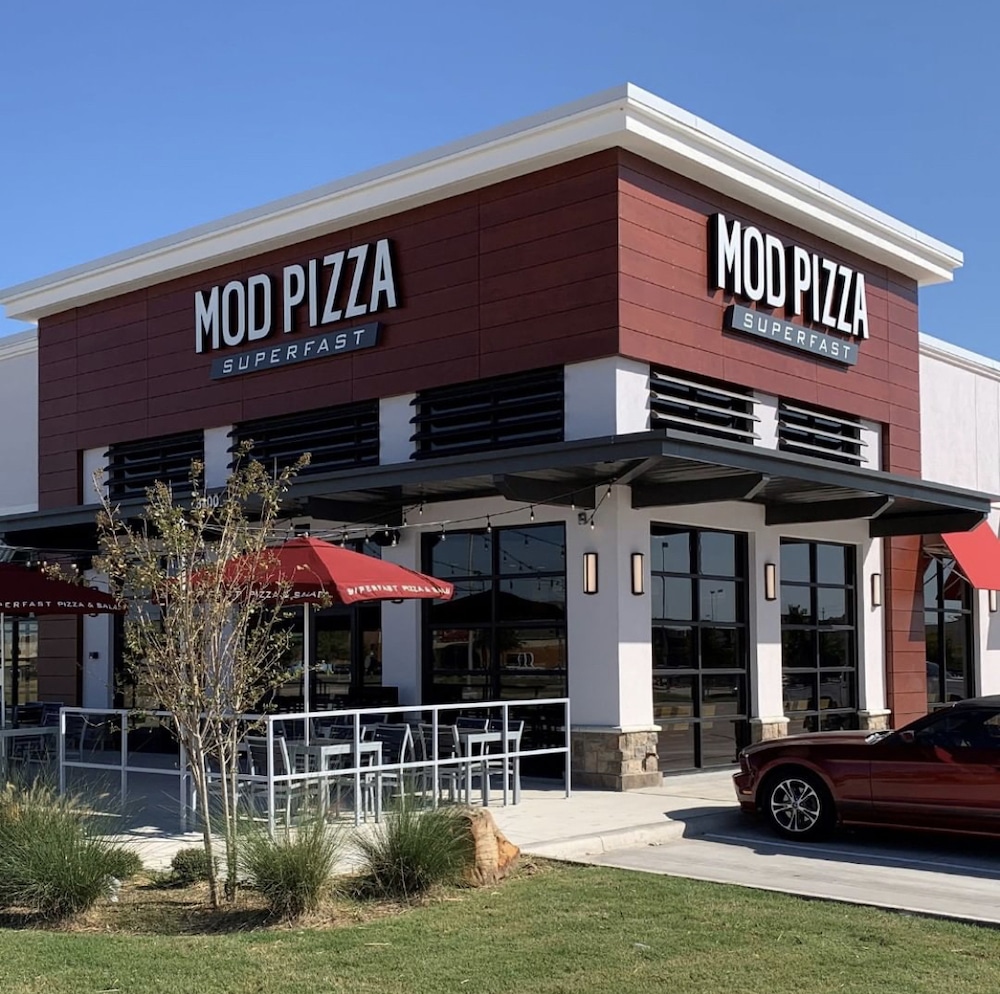 Frozen produce and improperly refrigerated meats can cost your pizzeria money in both wasted inventory and poor customer satisfaction. Ensuring you have the right type and amount of refrigerated storage can help reduce these losses.
Frozen produce and improperly refrigerated meats can cost your pizzeria money in both wasted inventory and poor customer satisfaction. Ensuring you have the right type and amount of refrigerated storage can help reduce these losses.
Refrigeration options for a pizzeria encompass three units: walk-in, reach-in and refrigerated prep tables. “In a typical restaurant, the walk-in holds your between commissary deliveries; the reach-in holds shift or full-day food supplies; and the prep table holds enough ingredients to cover your rushes,” says Marcus Bramhall, CEO, Pizza Equipment Supply Incorporated (PESI), Gastonia, North Carolina.
Backup Storage
As the granddaddy of refrigeration, a walk-in is the largest refrigerator/freezer storage unit. “You can choose a walk-in cooler box with or without a fl oor,” says Bramhall. “If you have an insulated or concrete floor, you can get away with a floorless walk-in.” If your pizzeria is located on a second story or has a wooden fl oor, you will need a fully enclosed model, because wood cannot maintain the temperature inside a walk-in. “The cool and moisture will also sweat and rot the wood,” says Bramhall. “If you choose a walk-in freezer over a refrigerator, you cannot go fl oorless unless you have properly prepped concrete.”
Walk-in units also offer three condenser options—self-contained, remote indoor and remote outdoor. “In a self-contained unit, the condenser is attached to the evaporator like an air-conditioning unit,” says Bramhall. “Then you have remote indoor, where the compressor is mounted somewhere else within the building, and remote outdoor, where the compressor is mounted outside the building.”
Self-contained units tend to be less expensive at the outset because they require no additional wiring or lines; you simply install the walk-in and plug it in. But there are some downsides to self-contained condensers. “There’s a lot of heat generated inside the kitchen, because the condenser is what dissipates the heat outside the unit,” says Steve Asay, vice president of sales and marketing, Kairak, Fullerton, California. “When you use a remote outdoor condenser, you save energy and cut your overall operation costs because you need less airconditioning to offset the heat generated by the unit. It costs more in the beginning, but you can recoup those costs in 14 to 18 months through energy savings.”
If you operate a high-volume pizzeria or simply don’t have the footprint to house a walk-in unit, you may choose a reach-in refrigerator/freezer to hold backup ingredients.
Reach-ins come in one- to four-door models, and they’re either a refrigerator or a dual-temperature refrigerator/freezer. “You can choose a single door with half-and-half refrigerator/freezer or, if you need more storage room, you might do a two-door dual-temperature unit with side-by-side refrigerator and freezer,” says Angelo Grillas, product manager, Electrolux, Fort Lauderdale, Florida.
When it comes to choosing your reach-in and walk-in, manufacturers offer everything from a basic chiller to high-tech units with a variety of bells and whistles. For new businesses, Bob Hamilton, vice president, Atlantic Refrigeration Company, Philadelphia, which distributes and services refrigeration units for restaurants, recommends keeping it simple. “For new businesses, we recommend a basic model with a thermostat and minimal added features,” he says. “The simpler the unit, the easier it is to maintain and repair. There are less components to break down, and you can often choose generic parts for repairs.”
For large-scale or chain pizzerias that require off-site monitoring of equipment and employees, companies offer special added features. “We offer a complete feedback system with monitoring points that tell you how many times the door was opened and if there are any changes in temperature within the box,” says Grillas. The system has both visual and auditory alarms that signal changes in temperature or usage. “You can hear it beeping and scroll through the screen to see what code went off,” he continues. “The system also offers a seven-day memory that can be printed out.”
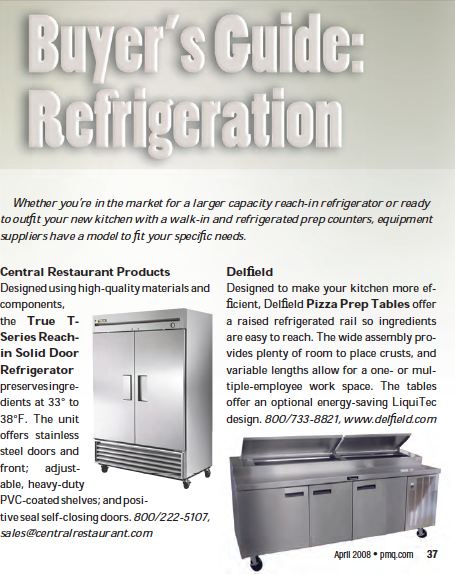 Prep Area Refrigeration
Prep Area Refrigeration
When it comes time to assemble your pizzas, prep tables house and organize all of your ingredients. “Most pizzerias will need a minimum two-door prep table; this gives you enough refrigeration to house your dough and toppings while providing a large enough surface to hold your pizza crust as you work,” says Joseph Ferrara, president, Marsal & Sons, Lindenhurst, New York. “But these units are also available up to 8’ long with multiple doors; the larger models allow you to have multiple people working on the same table.”
One of the challenges of manufacturing prep tables has involved creating enough refrigeration to maintain 38° to 40° temperatures all the way through the individual food bins. “Prep tables traditionally use a system that blows refrigerated air up from the base to the bottom of the pans,” says Asay. This bottom-up method works well when it comes to keeping food at the bottom of the pan chilled but sometimes fails to keep food at the top of the pan within National Sanitary Foundation (NSF-7)-regulated temperatures.
“In response, manufacturers created prep tables with recessed pans and louvers that blow cold air over the top of the food,” says Asay. “Then we moved to a system where the top rail is recessed three to four inches into the table and the rail itself is chilled to permeate cold above the food. The problem is that the employee needs to reach farther into the table as the food level in the pans goes down.”
Ten years ago, Kairak introduced a third option, which involves running a Freon line through each stainless steel divider bar so that each pan is surrounded by a chilled divider. “With this system, the pans are mounted at the surface of the rail so they remain easily accessible,” says Asay. This year, the company is expanding on this system by offering larger dividers chilled with food-grade glycol in its BLU line.
Marsal & Sons offers a prep table with a recessed sauce bowl. “You can ladel out the sauce at table level,” says Ferrara. “The recessed hole is refrigerated to keep the sauce at less than 40°F.”
Maintaining Your Units
Both new and refurbished units, like those offered by Barr, Inc. in Oshkosh, Wisconsin, include warranties on parts and labor. But you can keep your walkins, reach-ins and prep tables running coolly far past their warranty dates by following proper maintenance protocols. Your supplier can offer specific care instructions for each model, but general maintenance concerns include:
Condensers. The condenser draws the air into your unit to cool the compressor and exhaust heat. “The problem is, every time you draw in air, you’re drawing in dust, dirt and flour,” says Hamilton. “Over time, that restricts the airflow.” To keep your unit running smoothly, the condenser coil should be checked monthly. Some units feature filters that can be cleaned, while others recommend compressed air or whisks to clean out debris.
Door Seals. “The gaskets around the doors ensure that your refrigerator doors are properly sealed,” says Asay. “If they’re torn or have food built up on them, they won’t close properly. The food becomes warmer, and your compressor begins to work hotter.”
Prep Tables. If you don’t empty your prep table bins each night, “make sure all of the food is covered,” says Hamilton. “The acidity of foods like peppers and pickles will eat away at the evaporator and create pinhole leaks.”
